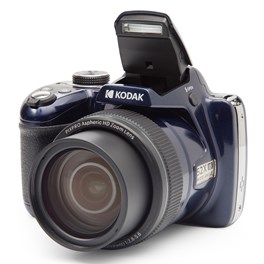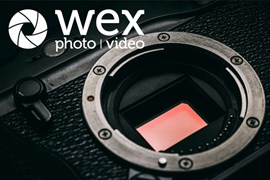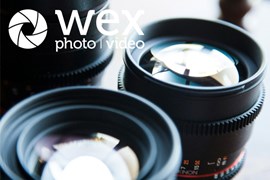
The best bridge cameras give you an all-in-one platform for getting great shots. Styled after SLRs, bridge cameras are essentially fixed lens compact cameras with one crucial difference – the fixed lens in question is a big old superzoom. With a good bridge camera, going from a wide-angle perspective to a super-zoomed telephoto is simply the matter of turning your wrist – and they are generally a more affordable choice than a mirrorless or DSLR camera with a big optical zoom lens.
Bridge cameras can range significantly in price, size and image quality – so we’ve put together this guide to help you find the best. With options from Sony, Panasonic, Canon and Kodak, these are the bridge cameras that have most impressed our team, with cheap options as well as the high-end stuff.
We’ve included the pros and cons of each camera to help give you an idea of which one could be right for you. So, let’s get started.
Our top picks
Kodak Pixpro AZ528 Digital Camera - Midnight Blue
The Kodak Pixpro AZ528 Digital Camera is perfect for photographers seeking zoom range without the hassle of multiple lenses. It boasts a 16mp resolution and scene modes which automatically adjust for technical aspects. Get close to the action or capture vast landscapes with a 52x optical zoom and 24mm wide-angle lens. The AZ255 features optical image stabilisation and shoots 1080p Full HD videos.
£249.00 View
Pros:
- Big zoom range
- Incredible value for money
- Optical stabilisation
Cons:
- Fixed rear screen
- No viewfinder
One of the newest bridge cameras around, the Kodak Pixpro AZ528 has proven that the format doesn’t quite belong in the past just yet. It pairs a 16MP 1/2.3-inch sensor with a 52x optical zoom lens that starts out at an equivalent of 24mm and can reach a whopping 1248mm equivalent. It also boasts 6fps burst shooting, and a sensible control layout that makes it intuitive to operate – though be aware the rear screen is fixed, and there’s no viewfinder to speak of
However, the real ace in the hole for the Kodak Pixpro AZ528 is its price tag – this bridge camera offers absolutely tremendous value for money. And what’s more, if it’s still out of your budget, Kodak also offers even cheaper bridge cameras with shorter zoom ranges. There’s the Kodak Pixpro AZ405 (40x optical zoom) and the ultra-affordable Kodak Pixpro AZ255 (25x optical zoom).
Pros:
- Lots of useful video features
- Built-in stabilisation and ND filters
Cons:
- Doesn’t zoom as far as the RX10 IV
With its 1in sensor and broad zoom range, the original FZ1000 presented a more affordable alternative to Sony’s Cyber-shot RX10 line – and with the FZ2000 the company refined this formula to create a hugely impressive bridge camera. While the sensor from the original appears to be unchanged, Panasonic has furnished the model with a fresh 24-480mm (equivalent) F2.8-4.5 optic, augmented by stabilisation and built-in ND filters.
The big addition is ramped-up video recording, the Lumix FZ2000 having been equipped with a huge range of pro-level features, including the option to record in both DCI 4K and UHD 4K flavours. Video shooters will also be pleased to note that the FZ2000 sports microphone and headphone sockets.
Pros:
- Can burst-shoot at up to 10fps
- Big 65x zoom
- Handles well with sturdy handgrip
Cons:
- Max 4K frame rate of 24p
Canon’s impressive bridge camera ticks all the boxes you’d want. The PowerShot SX70 HS packs in a zoom lens with a beefy 65x optical range, running from 21mm to 1,365mm equivalent. With built-in stabilisation and impressive autofocus, it’s equipped to handle shooting at such extreme range – and you can even use the digital zoom to further extend the reach to frankly silly levels.
With a solid handgrip and a vari-angle LCD screen, the PowerShot SX70 HS feels good to use, and with a total weight of just 610g, carrying it doesn’t feel like you’re lugging a brick around all day. Those who like to spend time post-processing their images will appreciate being able to shoot in uncompressed raw format.

FAQs
What is a bridge camera and how does it differ from other types of cameras?
A bridge camera is a hybrid between compact and DSLR/mirrorless cameras, offering larger sensors and versatile zoom lenses in a more portable form. Unlike compact cameras, bridges provide superior image quality and extensive focal range. They're more compact and user-friendly than DSLRs, making them ideal for enthusiasts.
What are the advantages of using a bridge camera?
Bridge cameras offer versatility with their wide focal range in a single lens, making them suitable for various shooting scenarios. They're portable, lightweight, and feature intuitive controls, appealing to both beginners and enthusiasts alike.
What are the limitations of bridge cameras?
Bridge cameras are limited by their smaller sensors, fixed lenses, and fewer customisation options compared to DSLRs or mirrorless cameras, compromising image quality and flexibility.
Are bridge cameras suitable for professional photography?
While not typically preferred by professionals due to their limitations, bridge cameras can suffice for specific professional tasks such as travel or documentary photography, offering convenience and decent image quality.
How do I choose the right bridge camera for my needs?
It’s best to think about what you want to photograph first. Once you know that, it’ll be easier to consider sensor size, zoom capabilities, manual controls, ergonomics, and additional features such as Wi-Fi connectivity or weather resistance.
How do we decide?
Our in-house photography experts, store staff and partners all work collaboratively to pour over our guides and tips articles. We also consider emerging trends and customer feedback to make sure our guides are always up-to-date and reflective of what people are truly looking for. By curating only the best products, our guides provide trustworthy recommendations, making it easier for customers to make informed choices with confidence.
If you would like more advice on any purchase our contact centre staff are here to help. Alternatively, you can reach us via email or social media. And don't forget. If you were to purchase anything based on our recommendations you'll be covered by our full returns policy








